| Botanical Name |
|
| Family |
Aizoaceae - The fig-marigold family or ice plant family |
| Pronunciation |
kar-poh-BROH-tus ED-yew-liss |
| Common Name(s) |
English: Sour fig; Cape fig; Hottentots fig
Afrikaans: Hottentotsvy; Suurvy
IsiXhosa: unomatyumtyum; igcukuma
IsiZulu: Ikhambilamabulawo; umgongozi
|
| Plant Group |
- Ground Cover A plant with a low-growing, spreading habit, grown specifically to cover the ground.
- Perennial A plant whose life cycle lasts for three or more seasons.
- Succulent A plant having fleshy stems or leaves often adapted to dry conditions.
|
| Plant Size |
- Small
| Tree | 4m to 8m |
| Shrub | 50cm to 75cm |
| Perennial/ground cover | 10cm to 20cm |
| Bulb | 20cm to 30cm |
| Succulent | 10cm to 20cm |
|
| Position |
- Dry Shade Shady areas where soil has poor water retention or are dependent on rain for their moisture needs.
- Partial Shade The area is in shade for part of the day and in full sun for part of the day.
- Sun The area is in full sun for all or most of the day, all year round.
|
| General Information |
- Drought Tolerance: High The plant is well adapted to arid conditions; it can survive long periods of drought and high temperatures without extra water.
- Evergreen Plants that have leaves all year round.
- Frost: Tender A plant that will not survive any frost or low winter temperatures.
- Salt spray tolerant A plant with specific adaptations enabling it to grow in a saline environment.
- Sand tolerant Plants adapted to survive in nutrient poor, very sandy soils.
- Water Wise Plant species originating from low rainfall regions that require less water to survive and thrive than other plant species.
- Wind Tolerant Plants able to withstand the effect of strong winds.
|
| Specific Information |
Carpobrotus edulis is an easy to grow, water wise succulent with large 3-angled leaves and edible fruits. It forms dense mats and is frequently used for stabilizing sandy areas, dunes and embankments. It is fire-resistant and can be planted around a property in fire-prone areas. Once established, this plant is truly water wise and requires little attention. Because this plant is often undisturbed for long periods of time, it creates a sanctuary for a variety of small creatures including reptiles, rodents and a range of bugs and beetles.
|
| Ad Break |
|
| Flowers |
| Description |
vygie flower 100 - 150mm in diameter
|
| Season |
- Winter to Spring Plants will seldom bloom for the entire season as given in the list, but should flower during a period within these parameters.
|
| Colour |
|
| Growth Rate |
- Very Fast Specifying growth rate can be very misleading as there is considerable variation of growth rate depending on type and species of plant, available water, supplementary feeding, mulching and general care, as well as the plants suitability and adaptability to the garden environment.
|
| Plant Uses |
- Attracts bees, butterflies or other insects This plant attracts insects which can be food for birds or other creatures in your garden.
- Barrier Plant A very thorny shrub, tree or scrambler that can be used to create an impenetrable barrier.
- Container Trees, shrubs and ornamental species that can adapt to growing in a restricted environment.
- Filler Either a fast growing tree or shrub used temporarily to fill in an area while the permanent plants grow to a desired size, or a plant used to fill gaps in borders or beds.
- Ground Cover Low-lying plants that spread fast, require minimal maintenance, and cover large expanses or bare areas between bulbs or shrubs. They provide protection from erosion and drought and improve the visual appearance of the garden.
- Mass Planting Plants useful for filling a large area with just one or a few kinds of plants spaced close together. Creates a bold, dramatic effect and to reduces maintenance.
- Pioneer for new gardens A very fast growing plant, able to withstand hardship, that can be used to populate land that has recently been cleared of natural vegetation. These plants pave the way for slower-growing species by adding nutrients to the soil and creating leaf litter.
- Retaining Walls Shallow rooted plants for cascading over dry stone walls or planting in hollow spots in retaining blocks.
- Rock Garden An area constructed of larger rocks, arranged naturally, to emphasise the use of stones as a main element. Generally plants used do not need a lot of care.
- Stabilize Banks Plant is used to prevent soil erosion because their roots will form a mat that stabilizes the soil and keeps it from washing away in heavy rains.
- Suitable for coastal gardens Plants adapted to dry, sandy soil, forceful wind, limited rainfall and intense sunlight.
- Suitable for seaside gardens Plants that will survive the hostile environment of harsh salty winds, dry sandy soil, irregular rainfall and heat found in seaside gardens.
- Wild Garden An indigenous garden planted for the benefit of wildlife and birds. Provides food, water, a variety of mini-biomes and no poisonous chemicals are used.
|
| Distribution and Habitat |
on coastal and inland slopes from Namaqualand in the Northern Cape, through the Western Cape to the Eastern Cape, often as a pioneer in disturbed sites
|
| Planting Suggestions |
Carpobrotus edulis thrives on neglect. It needs well-drained soil, a sunny position and room to spread. It is an excellent evergreen drought and wind resistant groundcover that thrives happily on flat, sandy ground and loose sand dunes, in stony soil and lime-rich or brackish soils. When planted as a groundcover around the house, this juicy vygie creates a fire-resistant barrier. Avoid use of fetilisers and compost.
|
| Medicinal Uses |
The leaf juice is astringent and mildly antiseptic. It is used internally, to treat diarrhoea, dysentery and stomach cramps, laryngitis, sore throat and mouth infections. A sore throat can be relieved by chewing a leaf tip and swallowing the juice. The juice from a crushed leaf relieves the pain of blue-bottle stings, and is used as a soothing lotion for burns, bruises, scrapes, sunburn, ringworm, eczema, dermatitis, herpes, nappy rash, thrush, cold sores, cracked lips, chafing, skin conditions and allergies. It has been reported that syrup made from the fruit has laxative properties. The leaf juice soothes the itch from mosquito, tick and spider bites, both for people and animals. The Khoikhoi used the fruits during pregnancy to ensure a strong, healthy baby and an easy birth. Leaf sap was applied to the head of a new-born baby to make it agile and strong.
|
| Ad Break |
|


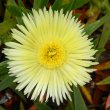
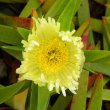
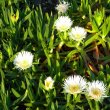
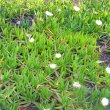
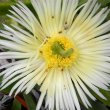


Comments
Caterpillars
I have been asked to look after the gardens in the complex I live in. We have large beds of sour figs which are doing very well. Last year I noticed that the beds were covered with what I thought were caterpillars. They were back and grey/silver and only ate the succulents but did not seem to harm them much. Have never seen these before and could not find a picture of them in my gardening books. Can you help?
Caterpillars on Carpobrotus
Hi Theresa
I can't recall ever seeing caterpillars on my Carpobrotus but last season most of the fruits on my plants had been infested with something and had gone soft and rotten. I have little knowledge of any but the most common caterpillars so I can't really help you. However I did some searching and found two South African sites that you may want to peruse to see if you find your caterpillars there.
This site shows unidentified caterpillars, which doesn't help too much:
https://picasaweb.google.com/103788100027081676391/CaterpillarsAndPupaUn...
This site shows identified insects of all sorts in categories and is really excellent:
www.insecta.co.za
Hope this helps.
Regards
Lorraine
Caterpillars
Morning Lorraine,
Thank you so much. Will have a look at both the sites.
Regards
Theresa
Carpobrotus edulis
I ran The First Medicinal Nursery in Magaliesburg, Gauteng, South Africa. During the three years that the nursery was in operation, I consumed about 50 of the largest, juiciest, succulent leaves daily, for the the two-and-a-half years that they were there. I started off by planting about 100 plants in specific areas. Within about 3 months they began to grow fast and furiously. The benefits were amazing. Most noticeable was my skin. It had become smooth and soft and supple. People that I came into contact with all commented on this. There were many other plants that I consumed at the nursery, but none so much as the easily obtainable Carpobrotus edulis or Sour Fig or Hottentot Fig.
Hi Charles
Hi Charles
Thanks for your fascinating comment. I had never thought of eating the leaves of this succulent but I did try one after I read your comment. I found it to be quite astringent although the taste was not altogether unpalatable. It is possible that our very dry conditions and the high lime content of my soil affect the flavour.
Regards
Lorraine
Carpobrotus edulis
Hi,
I live in Massachusetts. Can my Carpobrotus edulis survive the New England winter?
Thanks
John
Carpobrotus edulis
Hi John
I looked up New England weather and it appears that you have winter temperatures below freezing point, implying that you have quite a bit of frost. This plant, as you will note under the heading General Information above, is 'Frost tender'. This means that this plant cannot stand frost. These plants have a large amount of water in their leaves. Frost or icy temperatures cause the cells in the leaves to break down, resulting in the plant being reduced to mush.
Kind regards
Lorraine
Cape Wild Sour Figs
Hi
I am most curious to find out if the Cape sour figs has anything in common with the Hibiscus plant. I drink Hibiscus Tea and the taste is identical to the juice of the wild sour figs grown in the Cape region. Thank you Kindly.
Carpobrotus
Hi
No relation whatsoever. The Sour fig is a succulent and the Hibiscus is a woody shrub. The only thing they appear to have in common is the taste.
Kind regards
Lorraine
Discuss this plant
Share knowledge, ask a question or give an experience.